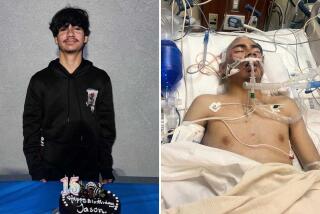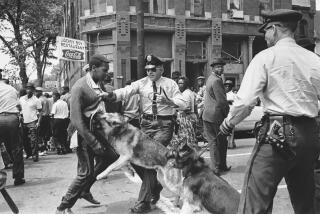Officer Wears Scars as a Badge of Courage
PHOENIX — An Associated Press series in June told how a police officer struggled to survive after a fiery patrol car crash burned away his face. This story details how he has since reclaimed his life.
*
PHOENIX -- On a sunny November morning, the officer grabs his briefcase and a carton filled with family photographs and climbs out of a pickup in the parking lot of police headquarters.
Clipped to his pants is a sparkling new badge. The old one, still smudged with soot, is displayed at home. Strung from his neck is a current photo ID. It replaces the one he no longer resembles.
As he strides inside, the officer wears the grin of a kid on the first day of school -- nervous anticipation infused with a childlike optimism that anything is possible.
He knows that better than most.
He has met President Bush, carried the Olympic torch and thrown out the first pitch at a major league baseball game, but a once-routine act -- getting dressed in the morning and driving to work -- he calls his “ultimate accomplishment.”
It is just one of many achievements for Phoenix Police Officer Jason Schechterle since a car explosion last year left him horribly disfigured and struggling to rediscover his identity -- and his life.
Schechterle was responding to an emergency call on March 26, 2001, when a cab driver suffered an epileptic seizure and slammed his vehicle into the back of the police cruiser, which erupted in a fireball. Schechterle was trapped for several minutes before firefighters and police could rescue him.
The blaze seared his hands, arms and legs but took direct aim at his head and face, which sustained fourth-degree burns. Surgeons at the Arizona Burn Center cut away all of the dead tissue to save his life.
The officer was stripped of his entire face -- ears, eyelids, eyebrows and all but a stump of nose.
In the year and a half since, Schechterle has continued to defy the odds and exceed expectations with his physical and emotional progress.
This summer, he embarked on a series of operations to repair some of his injuries. Schechterle began driving again in November and returned to work a week later. He now juggles his job and many public appearances, sharing his story with schoolchildren, burn victims and officers.
His happiest milestone came Oct. 29 when Masen, a 7-pound, 3-ounce baby boy, was born to him and his wife, Suzie.
“Going through this, he’s realized what the important things in life are,” said Dr. Kevin Foster, co-director of the Arizona Burn Center. “He just decided he’s going to be a normal human being again. And he has never looked back.”
Normal for Schechterle means busy:
He’s up at 6, out the door by 7, puts in an eight-hour day at the office and meets with his physical or speech therapists five times a week.
At home, while Suzie cooks dinner, he takes care of Masen, balancing a bottle in his mangled right hand. He instructs his 8-year-old stepdaughter, Kiley, to do her homework and plays disciplinarian to 4-year-old Zane.
“I feel like a husband and father again,” said Schechterle, who marvels at the similarities between Masen and his oldest son, who so closely resembles what Dad used to look like.
For Schechterle, Masen is the ultimate testament to how far he has come -- but also to the relationship between him and his wife, and the devotion that inspired his recovery.
“Suzie and Masen together,” he said, “make me feel as if nothing ever happened.”
His confidence has also been bolstered by an outpouring of support from friends and strangers alike. After the Associated Press narrative earlier this year that chronicled his accident and his fight to recover, Schechterle received thousands of cards, letters and e-mails from throughout the country.
One included a homemade rosary, another a $1,000 check in a card simply signed, “From an old granny.” A 13-year-old boy sent him a hand-drawn picture of his face, colored like an American flag.
When Schechterle first arrived home after the accident, Suzie fed him, bathed him, brushed his teeth, got him dressed. Now he does just about everything himself, although he still can’t manage buttons or shoelaces with hands left severely deformed by the fire.
He also put some weight back on, going from 132 pounds in the hospital to 166. Although he is still 25 pounds shy of his pre-accident weight, Schechterle insisted: “I feel very healthy and very strong.”
He couldn’t make the same claim earlier this year, when he underwent 11 different operations in five months to help reconstruct his neck, mouth, hands and eyes. He’s up to a total of 33 surgeries.
In May, he traveled to Virginia to meet with Robert Barron, a former CIA disguise expert who now makes custom prostheses for those maimed by accidents, disease and defects.
Barron molded two silicone ears and a nose. With liquid adhesive, Suzie can attach the parts in minutes, giving new life to a face devoid of distinguishing features.
“He wanted to look whole again, more natural,” Barron said.
Schechterle next consulted a plastic surgeon who works with Barron to improve the mobility in his neck and mouth, which were restricted by thick scars.
In June, Dr. Craig Dufresne inserted four silicone balloons into Jason’s chest and back to stretch the uninjured skin so that it could be redistributed to replace the scar tissue around his neck. Every week for almost two months, doctors injected each balloon with up to 3 ounces of saline to make them swell.
“It’s like when a woman becomes pregnant,” Dufresne said. “The expanding fetus also expands the muscle and the skin. When the baby’s delivered, the tissue doesn’t always go back to the way it was.”
As Schechterle put it: “I looked like the hunchback of Notre Dame.”
The procedure was not without complications. In July, during Schechterle’s first police ride-along since the accident, his former partner, Bryan Chapman, noticed blood on his shirt and rushed him to the Arizona Burn Center. Blood from raw tissue was seeping through his sutures.
In early September, Dufresne removed the implants, sliced away some of Schechterle’s scar tissue and re-draped the new skin from the base of his neck to the base of his skull. Then, using skin grafts from Schechterle’s abdomen, he remade the upper and lower lips.
Now, Schechterle can turn his head with ease and close his lips. He can even eat a cheeseburger.
Also this summer, Schechterle had three painful operations to attempt to restore mobility to his right fingers. Earlier operations -- including one last year in which Schechterle’s left index finger was transplanted to give him a new thumb -- restored what’s called “key pinch” to both hands.
It is that function, the squeezing of his thumbs and forefingers, that enables him to turn on a car, grip the steering wheel, write his name and hold his baby’s bottle.
Schechterle has other ambitions. He plans to meet with a woman who teaches the disabled to play golf; he once excelled at the game. And he is determined to shoot a gun again.
“I know there are some things that I will never do again, and most things I will never do the same way again, but I am dedicated to getting as much of my life back as I can,” he said.
Perhaps the most successful treatment to date has involved Schechterle’s eyes, which were so badly scarred that he was legally blind.
Dr. William McLeish of the Mayo Clinic in Scottsdale used special eyedrops to heal the corneas, then rebuilt Schechterle’s eyelids using cartilage from what was left of his nose and inserted a new tear duct in his right eye.
Schechterle was fitted with a contact lens that improved the vision in his left eye to almost 20-20, and McLeish hopes to do the same for the right eye.
Among Schechterle’s top goals was to get back behind the wheel. Shortly after his 30th birthday in November, he purchased a new, electric-blue pickup. Unlike his old truck, this one has an automatic transmission and remote keyless entry, making it easier to handle.
He was more adamant about work and set a target: Once the baby arrived, he was going back.
Two weeks after Masen was born, Schechterle returned to the department as a public affairs liaison. Although he misses patrol duty, he is thrilled to wear a badge again.
“Just because I don’t have a gun, just because I’m not taking somebody to jail, doesn’t mean I’m not doing what I wanted to do,” he said. “I’m just taking a little different route.”
Despite his accomplishments, Schechterle still struggles with his appearance.
He can speak in front of hundreds of people, Suzie notes, but he won’t go to the grocery store or visit the park until sundown. Earlier this year, while in New York to meet with a specialist, he wouldn’t leave the hotel until his friends bought him an oversized sweatshirt with a hood.
Chapman, his friend, offers an explanation: “It’s not something he’s ashamed of, but he doesn’t want to frighten other people who aren’t prepared to see something like that.”
Some are scared. During one recent speech, a third-grader blurted out: “I think you’re gonna give me nightmares tonight.”
All Schechterle could say was, “I’m sorry, buddy.”
“It doesn’t upset me because it’s a child,” he said later. “But it’s also a sad reminder.”
He worries about embarrassing his own children once they get older, says Suzie, who insists that those fears are unfounded.
“Kiley is instant popularity because of who her dad is. All the little kids Zane goes to preschool with know who Dad is. But he still worries,” she said. “He never wants to be a burden.”
For now, Schechterle plans to forgo further reconstructive work on his face. One specialist suggested rebuilding it piece-by-piece using skin grafts from the rest of his body, but the procedure seemed too invasive, and Schechterle knows that little can be done to restore his appearance.
He doesn’t even wear his prosthetic ears and nose all that often because they replace only a small piece of the missing puzzle.
“People don’t look at me and go, ‘You don’t have any ears!’ That’s not what they’re looking at. I am one full scar from the neck up,” he said. “Appearance is never going to look good.”
Suzie sees it another way: “It’s a badge of courage he wears.”
Schechterle will always fight contracting scars that could limit his motion, but ongoing therapy and surgery can correct that. In the meantime, he wants to focus on family and work -- the two things most responsible for his emotional recovery.
Friends also credit something else. In one critical way, Schechterle hasn’t changed at all. When he sets his mind to something, he’ll do whatever it takes to accomplish it.
And Jason Schechterle was determined to reclaim his life.
“He doesn’t look at something as a challenge or obstacle,” Chapman said. “He looks at it as when he’s going to overcome those challenges and obstacles. That’s his idea of winning.”
“Jason really just made a choice,” added Sgt. Lauri Williams, Schechterle’s supervisor at the police department. “ ‘The destiny of my life is in my own hands. And I want to be happy.’
“He’ll exude to you the power of his spirit, the power of his life.”
*
On the Web:
https://www.phoenix.gov/police/500ccp2.html
More to Read
Go beyond the scoreboard
Get the latest on L.A.'s teams in the daily Sports Report newsletter.
You may occasionally receive promotional content from the Los Angeles Times.










